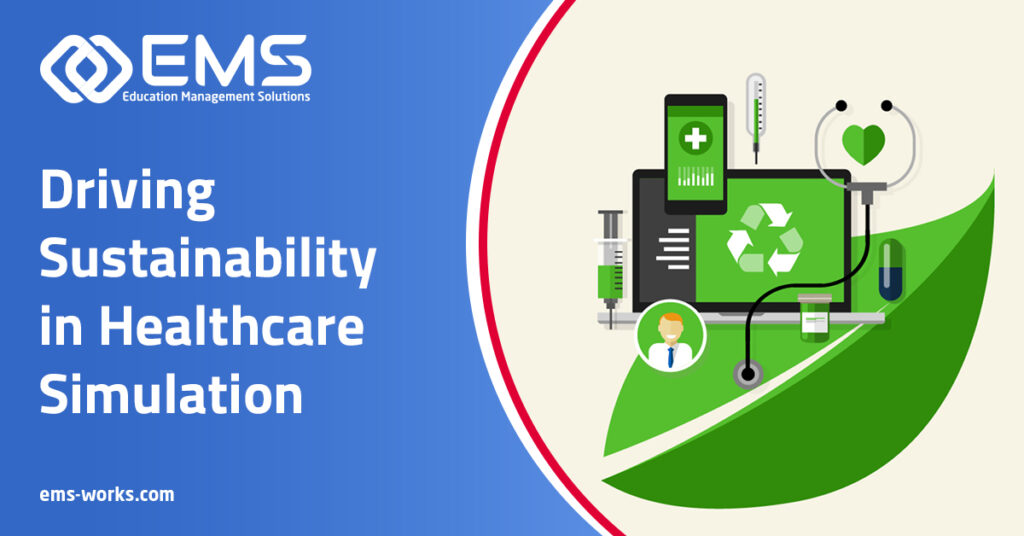In an era where environmentally conscious practices are increasingly becoming a priority, sustainability has emerged as a key focus in healthcare education and simulation training. As training institutions face mounting pressure to balance environmental stewardship with the demands of rigorous, standardized education, healthcare simulation leaders are innovating to create sustainable solutions.
This blog explores the challenges surrounding sustainability in healthcare simulation, innovative solutions being implemented, and the critical role technology plays in transforming the field for a greener future.
The Sustainability Imperative in Healthcare Simulation
Global healthcare simulation programs generate a significant environmental footprint, as they often rely on high-quality materials, energy-intensive processes, and disposable products to mimic real-life medical scenarios. In addition, outdated practices, including single-use simulation materials, can strain institutions’ operational budgets while contributing to waste.
The healthcare sector as a whole accounts for nearly 4.4% of global greenhouse gas emissions, according to a 2019 report by Health Care Without Harm. While healthcare simulation represents only small fraction of that number, addressing sustainability practices within the discipline can make a marked difference in reducing the environmental impact of medical education while improving cost efficiency for institutions.
Challenges to Sustainability in Healthcare Simulation
Adopting sustainable practices in healthcare simulation comes with its unique set of challenges, including:
- Material Waste: Simulation centers often rely on single-use task trainers, anatomical models, and components that are not reusable, resulting in large amounts of nonbiodegradable waste.
- Cost Concerns: Investing in reusable or eco-friendly simulation tools often presents a higher upfront cost, which is difficult to justify for institutions with limited budgets.
- Energy-Intensive Operations: Simulation centers depend on advanced technologies such as manikins, audiovisual recording systems, and virtual or augmented reality, which can be energy-intensive to implement.
- Lack of Standardized Practices: There is limited guidance or standardization in integrating sustainable practices, making it challenging for institutions to know where to begin.
These challenges are significant but not insurmountable. With innovative approaches, simulation centers can not only reduce environmental impact but also improve ROI by optimizing operational efficiency.
Sustainable Solutions in Healthcare Simulation
Forward-thinking healthcare simulation organizations are responding with cutting-edge solutions that address these challenges while maintaining the highest training standards.
- Transition to Digital and Virtual Simulation
Virtual simulation tools have become essential for reducing resource-intensive training. Leveraging virtual reality, augmented reality, and web-based learning modules can deliver high-quality, immersive training without the need for physical task trainers or disposable materials.
Benefits:
- Significantly reduced use of plastic models and physical assets.
- Improved scalability: Training can be deployed remotely, eliminating travel emissions.
- Increased cost efficiency by lowering recurring purchases of materials.
- Reusability and Modular Design
Manufacturing reusable, modular components enables simulation centers to extend the lifecycle of equipment. Modular manikins, for instance, can be updated or repaired rather than discarded, which minimizes waste and optimizes budgets.
- Energy-Efficient Infrastructure
Modern simulation centers are shifting toward “green” infrastructure by utilizing energy-efficient audiovisual recording systems, smart environmental controls, and centralized IT management solutions.
Key Outcomes:
- Lower operating costs with reduced energy consumption.
- Compliance with sustainability-based funding requirements for government or public institutions.
- Priority on Data and Outcome Efficiency
Sustainability isn’t just about materials and energy—it’s about operating smarter. Simulation management platforms use data-driven insights to improve operational efficiency for institutions, identifying underutilized resources and optimizing simulation schedules to minimize waste.
ROI of Sustainable Simulation Practices
By integrating sustainability into simulation training, institutions can realize significant financial and operational returns:
- Cost Savings: Transitioning to reusable or digital tools reduces reordering costs while maximizing the lifetime value of investments.
- Regulatory Alignment: Institutions adopting eco-friendly solutions often qualify for green certifications and grants, securing additional funding.
- Reputation Enhancement: Adopting sustainable practices signals institutional leadership and attracts environmentally conscious students and stakeholders.
A Commitment to Sustainable Innovation
As the healthcare simulation industry continues to evolve, sustainability is no longer optional—it is essential. By embracing new technologies and adopting data-driven strategies, institutions can confidently address the environmental and operational challenges of the future.
At EMS, our mission goes beyond empowering simulation centers with advanced technologies—we’re committed to helping institutions achieve superior training outcomes without straining budgets. Contact an solutions expert today to learn more about EMS’s cost-effective solutions and how they can be customized for your training program’s needs.

